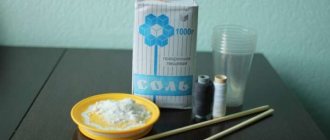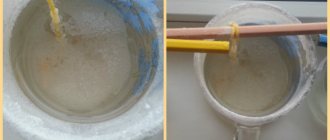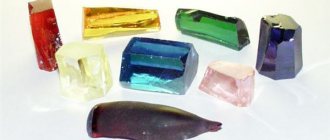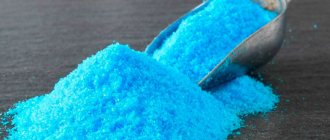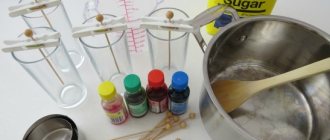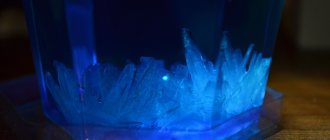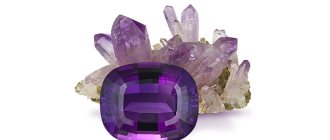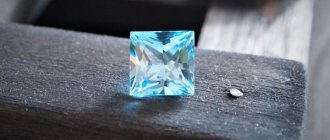Organic salts
It is easy to grow a ruby crystal from various salts:
- copper sulfate;
- potassium alum;
- regular salt.
The longest salt-based process, the most beautiful specimens are obtained from vitriol. The production of ruby crystals is based on the following stages:
- Preparing the container. It should hold salt and a saturated water-salt solution. They take hot water. The process is gradual. Dilute two tablespoons with water and mix thoroughly. Then salt is added and mixed. You need to sprinkle until the salt stops dissolving. To maintain the proportions, take a hint: a table of the solubility of different salts in 100 ml of water, their relationship with the temperature of the liquid.
- Filtration of the solution. The solution must be clean. Dirt impurities will ruin the structure of the stone. Defects will be visible in it. The solution remains for 24 hours. During this period, crystals form at the bottom of the container. They will become the basis of the ruby.
- Growth of an artificial mineral. A fishing line is tied to the stone formed at the bottom of the glass. It is wound around a pencil or wooden stick. The device is installed on the container. The crystal is in solution, in a suspended state. Water tends to evaporate, the saturated saline solution releases excess, which is fixed on the resulting sample.
- Adding salt solution. You always need a certain amount of water; if it becomes too little, the crystal will stop growing. At normal room temperature, water is added once every 2 weeks.
To obtain rubies at home, you will have to wait about 3 months. Then the stone is freed from the saline solution and dried with a soft cloth. The sample is coated with colorless nail polish in several layers.
Advice from experienced crystal creators. The salt solution should be at the same temperature as the water in the container. The crystal grows at a temperature slightly lower, but high rises in solutions spoil and stop the growth.
Device for working at home
To create rubies at home, you will need a machine named after its creator, Verneuil. The inventor's technique allows him to grow a ruby weighing 30 carats in 3 hours. Technology has made it possible to create precious material in the required quantities. Industrial capacities began to actively implement Verneuil's development. Time has made its own adjustments, and today such a device is easily assembled at home. Components of the device:
- cathetometer;
- shaking mechanism;
- bunker;
- burner;
- muffle;
- growing crystal;
- crystal holder;
- crystal lowering mechanism.
The device is used for growing not only rubies. The device often creates blue topaz, emeralds and stones with a translucent transparent structure.
Home production process:
- Powder is poured into the hopper through a funnel. The composition of the powder is Al2O3, the additional component is Cr2O3.
- Using a burner, a flame is supplied to the bottom of the hopper.
- The powder begins to melt.
- The layers of molten powder are a growing ruby crystal.
Through the lowering mechanism, the artificial mineral moves down. The device can produce different shades. The rate of crystal formation is higher than in a container. It will only take 3 hours, and you can admire the ruby. For one sample the following volumes of components are needed:
The raw crystalline formations are extraordinary in form. They are originally similar to natural ones, but at the same time always unique.
Working with the device at first glance is complex and painstaking. In fact, the device, invented by a French inventor more than 100 years ago, will not create any special problems. It is assembled from parts that practical people have on their farms. Making a device and purchasing powder are the main stages of preparation.
How to make a crystal in Minecraft
End Crystals are found in the Ender dimension on top of obsidian towers. They look like pink cubes enclosed inside two transparent ones. Their property is to fuel the health of dragons. In Minecraft 1.8, you will get a crystal by killing a skeleton horse or a zombie horse.
You can make an Ender crystal yourself (in version 1.9). For this you will need:
- glass 7 – pcs.;
- Eye of the Edge – 1 pc.;
- ghast tear – 1 pc.
In the Minecraft 1.12.2 modification you will find vanilla ores and rocks from other mods in the mines and Ender. All this is needed to cast your spells. Thaumcraft also uses 6 types of crystals and 2 types formed when structures are destroyed.
Video on how to grow crystals:
Properties of natural rose quartz
In the cultures of different nations, the pink variety of quartz served as a symbol of harmony and love. Many people believed that the gem helped in strengthening determination and healing the heart. And if you keep the stone among amethysts, it will greatly enhance its abilities.
Rose quartz is a symbol of love.
Today the mineral has found use in energy medicine and massage therapy. It is believed to have the following medicinal properties:
- restores the nervous system;
- stabilizes blood pressure;
- helps normalize kidney function;
- activates the work of the endocrine glands;
- increases immunity;
- slows down the aging process.
Economic calculations
Producing rubies at home is very economical. When growing crystals from salt, you need to calculate the cost of all components. Using a Verneuil apparatus may cost a little more, since you will need to add the costs of manufacturing the unit itself and energy costs. In both cases, synthetic rubies are much more expensive, so their production is cost-effective.
Separately, it is worth mentioning such a point as legislation in the field of circulation of precious stones. In Russia, strict control is exercised over the production and sale of natural minerals, and artificially created samples are not mentioned. If you manage to find markets and put the production of rubies on stream, it is best to register your business activity in the prescribed manner to avoid problems with the tax authorities.
Now it remains to settle your product with the legislation of the Russian Federation “On Precious Metals and Precious Stones”. And it says that the object of this law is “precious stones,” and these include natural amber formations. And the most interesting thing is that there are no synthetic stones among them! So work calmly and profitably!
The history of the appearance of synthesized stones
Attempts to synthesize gemstones have been made for centuries, but Auguste Verneuil was the first to obtain large enough samples. The first synthetic stone was ruby. Already at the beginning of the 20th century, red corundum began to be synthesized on an industrial scale - like many stones, rubies are used not only in jewelry, but also in industry.
Various methods are used to grow the mineral, but they still have a common principle: low-quality raw materials are crushed, and on its basis the stone is grown under artificial conditions. Most often used:
- Verneuil method – for sapphire, ruby, spinel, rutile and fabulite. Based on the use of natural low-grade raw materials, crushed into powder (charge) and seed.
- The Czochralski method is for growing alexandrite, sapphire, garnet, spinel, tanzanion. Used since the 1950s, it makes it possible to grow large crystals by controlling their growth. In English, such stones are called pulled, which means “stretched”. The mineral is literally pulled out of the melt of the raw material.
- Hydrothermal (h/t) method – for emerald, aquamarine, morganite, sapphire, ruby, beryl. The crushed natural stone is transferred into an aqueous solution, and a crystal with a reconstructed structure is recreated in autoclaves.
Soda crystals
Baking soda crystals are grown using the same principle as salt crystals. But to create a saturated solution, it is very important that the water is as soft and pure as possible, ideally distilled, or at least well filtered.
Soda is dissolved in hot water until a saturated solution is obtained (the soda stops dissolving), after which the solution is filtered and the container is put in a warm place. After some time, crystals begin to appear on the bottom and walls of the vessel. This moment is the most successful for placing an object in a container, the contours of which will gradually become overgrown with crystals.
It should be remembered that, unlike crystals obtained from salt and alum, soda is highly susceptible to moisture in the air, so these crystals can be easily destroyed. To protect them from deformation, soda crystals are stored in a tightly closed container.
Astrological compatibility
In general terms, it is difficult to describe the influence of quartz on a particular sign of the Zodiac - the question again comes down to the diversity of its types. The fact is that some of them have directly opposite astrological characteristics, and may relate differently to the same zodiac signs.
Pure and flawless rock crystal is perfect for Pisces, Leos, Taurus and Libra. It helps these signs to establish a connection with their own inner world and find spiritual harmony.
If your Zodiac sign is Libra, Cancer, Aquarius or Taurus, pay attention to rose quartz. A small pendant or beads with this stone will have a positive effect on self-esteem. The gem will help stir up shy and modest people, unsure of their abilities and those who are afraid of making a mistake.
A zodiac sign such as Scorpio interacts well with rauchtopaz, which has a calming effect on the personality, restraining negative character traits. This leads to positive changes in personal and business spheres. For Libra and Capricorn, alliance with rauchtopaz also brings great benefits. The first ones become balanced and reasonable, which helps well in making decisions, while the second ones discover their purpose, the stone helps them find their path in life.
As we can see, almost all varieties of quartz have a special location for Libra, Scorpio, Aquarius and Sagittarius. Perhaps people born under these constellations can try on any variety of quartz.
But a sign like Gemini, according to astrologers, should be careful about wearing quartz. Perhaps avoid it altogether. This stone is also contraindicated for Virgos. In both cases, the mineral has a negative effect on the emotional state.
What can be done from grown crystals. How can you make money growing crystals?
This is the question of why this article was written. The first thing that comes to mind is the recruitment of a young chemist. Not just a set, but a set with detailed instructions for growing crystals included on the disk. The main thing in this matter is not to overprice. Since many ingredients are sold in gardening stores and do not cost much money.
Secondly, these are sets for adults. They’re called “wishing jars,” you grow crystals and make a wish. It will grow up, which means it will come true; if it grows up small, it means it will not be the way you wanted it to be. Well, if it doesn’t grow at all, then the answer is immediately known.
Third. Sugar sticks for cafe and restaurant owners. They will be a pleasant surprise for customers and will diversify children's leisure time.
Fourth. This is the making of various souvenirs; when growing crystals, you can use various beads and rings. Gluing crystals together will be especially beautiful if the colors of the crystals are slightly different shades. You can combine them with semi-precious stones, decorate them with various cold porcelain products, etc.
And finally, fifth. This is growing large crystals for custom gifts.
Mineral deposits and processing
Quartz deposits are found on all continents. The rock occurs in mountains, plains, seas and rivers. Mining is carried out manually and in a quarry.
The largest deposits of ornamental and semi-precious stones:
- Brazil;
- Ukraine;
- Uruguay;
- Kazakhstan;
- Mexico;
- Madagascar.
In Russia, quartz deposits are located in Yakutia, the Urals, Chukotka, and the Moscow region.
Processing of the rock depends on the purpose of use. Large layers of ornamental quartz are almost not processed. They are given the correct shape and used in architecture.
Stone fragments are turned into quartz chips or dust used in industry.
The cleaned stone decreases in size, but acquires a beautiful color.
Additional story about quartz from a stone specialist:
Growing radiant crystals
Radiant crystals are sold in special sets for schoolchildren.
The set contains all the necessary elements:
- chemical reagent;
- pallet;
- cardboards;
- instructions.
- We take cardboard strips and cut them into 4 parts and stick them into the pallet. Fill in the reagent and wait 24 hours.
Video: crystal from the set
Growing crystals will bring a lot of pleasure not only to children, but also to adults. Each new pebble will be unique and inimitable. They can be used as a gift or as decoration. In addition, this will help instill in schoolchildren an interest in science.
Tips for home experiments
There are many techniques on how to grow a diamond yourself at home. Here are some simple tips on how to make this process more interesting and the result beautiful:
- The crystal can also be grown from sugar or citric acid.
- It is better to take boiled water, it contains fewer impurities and minerals.
- When using rock salt, the solution often turns out grayish, with impurities and particles of dirt. It must be carefully filtered through cotton wool and filter paper. Then the crystal will turn out to be more regular in shape.
- For the seed - the center of crystallization - you need to choose a beautiful and neat crystal of the substance.
- As the solution evaporates, it will have to be added if you want to grow a large crystal. In addition, it is important to ensure that the growing gem does not peek out from under the water. If other stones appear near the main crystal, they should be removed.
- Use food coloring to grow a wide variety of "gems".
- Instead of sodium chloride (table salt), other salts are useful: copper sulfate - for homemade turquoise, alum based on aluminum, potassium, chromium - for lilac stones.
To prevent the liquid from evaporating so quickly, you can cover the glass with a piece of plain paper.
Safety precautions
Food containers should not be used to grow crystals (with the exception of experiments with salt and sugar). You should not leave food nearby: firstly, because the reagents are toxic, and secondly, because of debris and crumbs, which, if they get into the solution, will ruin the experiment.
When manipulating chemical reagents, you must follow absolutely all the rules indicated on the packaging. Upon completion of work, you should wash your hands.
Growing a crystal at home is quite simple, interesting and educational. First, it is better to practice on available substances. If something goes wrong, you need to check that all the conditions necessary for the formation of a crystal are met. Having mastered the simplest crystals, you can begin to work with other reagents. It never gets boring because different substances produce crystals of different shapes and colors. In addition, no two crystals are exactly alike, and their configuration and size can be adjusted at will.
How to quickly grow a crystal from table salt and water
When wondering how to grow a crystal from salt, be prepared that this task will take you from 3 weeks to 6-7 months, depending on the desired size of the final product. The resulting stone will be very brittle, so you should not touch it with your hands. To preserve such a masterpiece for a long time, coat the product with clear varnish. Let's look at the step-by-step process of preparing a crystal from table salt:
- Take a small container, preferably transparent.
- Mix clean distilled water at room temperature with salt. Pour in a lot of the second ingredient until mixing with the liquid becomes difficult. After the solution is saturated, place this dish in a water bath and melt the salt in it until a homogeneous mass is obtained.
- Using thick gauze or a napkin, strain the liquid to remove solid impurities.
- Next, take an ordinary white thread, tie a small crystal of salt to it and lower it to the cooled liquid. If there is no such stone, take any hard plastic object, previously soaked in prepared water and dried.
- Tie a crossbar (for example, a pencil, ruler or pen) to the second edge of the thread, which will be wider than the neck of the selected dish. This item will be fixed to a container of salt water so that the small crystal on the thread is suspended.
- Cover the resulting structure with paper, napkins or cloth and place it in a place where temperature changes are least noticeable.
- If the selected container is transparent, then it is easy to see how fast the salt crystal is growing. If the dimensions are not visible, from time to time you can lift the thread with the stone and check. But do not touch it with your fingers and do not catch the stone on the edges of the structure.
- After a month, the product will increase in size and become at least the size of a bean.
- After waiting a little more (2 months), you will find that the stone has become about 3-4 cm in diameter.
- If you are satisfied with the size of the crystal, take it out, wipe it with dry cloths and cover it with clear varnish (nail or other). When the substance dries, the stone can be picked up and admired.
quartz
Quartz is one of the most common minerals in the earth's crust, the rock-forming mineral of most igneous and metamorphic rocks. Free content in the earth's crust is 12%. It is part of other minerals in the form of mixtures and silicates. In total, the mass fraction of quartz in the earth's crust is more than 60%.
Origin of name.
The word "quartz" is a calque of the German word Quarz, which comes from the Middle High German twarc, which means "solid." The word has Slavic roots; in the Proto-Slavic language it has the form *tvьrdъ. According to other sources, the name comes from him. Querklufterz, Quererz - “ore of cutting veins.”
Morphology.
Quartz crystals are hexagonal prisms, topped at one end (rarely at both) with a six- or three-sided pyramidal head, combining the faces of two rhombohedrons. Often, towards the head, the crystal gradually narrows. The faces of the prism are characterized by transverse shading. Quartz single crystals can have right-handed and left-handed shapes.
In igneous and metamorphic rocks, quartz forms irregular isometric grains intergrown with grains of other minerals; its crystals are often encrusted with voids and almonds in effusive rocks.
In sedimentary rocks - nodules, veinlets, secretions, brushes of small short-prismatic crystals on the walls of voids in limestone, etc. Also fragments of various shapes and sizes, pebbles, sand.
Properties.
In its pure form, quartz is colorless or has a white color due to internal cracks and crystalline defects. Impurity elements and microscopic inclusions of other minerals, mainly iron oxides, give it a wide variety of colors. Among the color varieties of quartz are almost black morion, violet (amethyst), yellow (citrine), etc. The reasons for the color of some varieties of quartz have their own specific nature. Artificial crystals are also given green (very rare in nature) and blue (there are no natural analogues) colors.
The luster is glassy, sometimes greasy in solid masses, the fracture is uneven or conchoidal. There is no cleavage.
Quartz often forms twins. There are many laws of twinning, the main ones being the Brazilian and Dauphine laws.
Melting point 1713–1728 °C (due to the high viscosity of the melt, determining the melting point is difficult; there are different data). Dielectric, piezoelectric.
Minerals and varieties of quartz.
- Aventurine is a yellowish or shimmering brownish-red quartzite (due to inclusions of mica and iron mica).
- Agate is a layered-banded variety of chalcedony.
- Amethyst is purple.
- Ametrine is bicolor, violet-yellow.
- Binghemite is an iridescent quartz with goethite inclusions.
- Volosatik is rock crystal with inclusions of finely needle-shaped crystals of rutile, tourmaline and/or other minerals that form needle-shaped crystals.
- Rock crystal is crystals of colorless transparent quartz.
- Flint - fine-grained cryptocrystalline silica aggregates of variable composition, consisting mainly of quartz and to a lesser extent chalcedony, cristobalite, sometimes with the presence of a small amount of opal. Usually found in the form of nodules or pebbles that arise when they are destroyed.
- Lemotrin is a bicolor yellow-brown.
- Morion is black.
- Prazem is green (due to actinolite inclusions).
- Prasiolite is onion-green, obtained artificially by calcining yellow quartz.
- Rauchtopaz (smoky quartz) - light gray or light brown.
- Rose quartz is pink.
- Chalcedony is a cryptocrystalline fine-fiber variety. Translucent or translucent, color from white to honey yellow. Forms spherulites, spherulite crusts, pseudostalactites or continuous massive formations.
- Citrine is lemon yellow.
- Sapphire quartz is a bluish, coarse-grained quartz aggregate.
- Cat's eye - white, pinkish, gray quartz with a light tint effect.
- Hawkeye is a silicified aggregate of bluish-gray amphibole.
- Tiger's Eye - Similar to Hawk's Eye, but golden brown in color.
Origin.
Quartz is formed during various geological processes: Directly crystallizes from acidic magma. Quartz contains both intrusive (granite, diorite) and effusive (rhyolite, dacite) rocks of acidic and intermediate composition, and can be found in igneous rocks of basic composition (quartz gabbro). According to measurements using geobarothermometry methods, quartz is released in granites at T>700 °C (analysis by melt inclusion method, isotope geothermometry). In acidic volcanic rocks it often forms porphyry phenocrysts. The temperature of its release can exceed 1000 °C.
Quartz crystallizes from fluid-enriched pegmatite magmas and is one of the main minerals of granitic pegmatites. Quartz is the main mineral of apogranitic metasomatites - greisens.
During the hydrothermal process, quartz and crystal-bearing veins are formed. Beautiful geodes made from quartz minerals, often with an agate shell, are not uncommon.
Widely distributed in sedimentary strata, often found in limestones, dolomites and other rocks in the form of nodules, geodes, fine-crystalline crusts and veinlets in cracks. When weathered under surface conditions, quartz is stable and accumulates in placers of various origins (coastal-marine, aeolian, alluvial, etc.) in the form of rounded pebbles. The main mineral of sands and sandstones, and deposits of monomineral quartz sands are of great industrial importance.
In industry, quartz is synthesized using the hydrothermal method. The advantage of synthetic quartz for industry is greater uniformity of impurities and higher chemical purity. Another advantage of the synthesis method is that the result of growth is single crystals, which in their properties are more suitable for use as piezo-optic quartz than twinned crystals, which are widespread in nature. For the jewelry industry, the synthesis method is also important, since it makes it possible to obtain quartz of almost any color, of very different saturations, if necessary, even with transitions from one color to another. They even grow blue quartz (perunite), which does not exist in nature.
Practical significance.
Valuable mineral raw materials: used in optical instruments, in ultrasound generators, in telephone and radio equipment (as a piezoelectric), in electronic devices (“quartz” in technical slang is sometimes called a quartz resonator - a component of devices for stabilizing the frequency of electronic generators). It is consumed in large quantities by the glass and ceramics industries (rock crystal and pure quartz sand). It is also used in the production of silica refractories and quartz glass. Many varieties are used in jewelry.
vote
Article rating
How to grow artificial ruby
Growing synthetic rocks can turn from a fun hobby into a real home business idea. There is a well-known way to make a ruby using various salts or even sugar. The process will take quite a long time, and the quality of the resulting crystal ultimately does not satisfy many.
To set up home ruby production, you should purchase a special Verneuil apparatus. This scientist was the first to make a stone that resembles a real gem in composition and quality. Literally before our eyes, a ruby up to 30 carats in size grows, which amazes with its beauty and attractiveness.
The technology is quite simple and can be done by anyone who wants to do this business.
- An aluminum dioxide salt containing an admixture of chromium oxide is placed in the system's storage tank.
- An oxygen-hydrogen burner melts the mixture.
- The crystal “grows” literally before our eyes.
The color of the resulting stone can be adjusted independently by selecting different salts. This type of work requires care and consistency. The resulting crystals lend themselves perfectly to further processing and polishing. They turn out very beautiful and transparent. They are happily bought by jewelers to create various jewelry, craftsmen who make interesting compositions and crafts.
The resulting synthetic rubies are, of course, not jewelry. Professionals have simple ways to check the authenticity of the material, but even with a visual inspection they see the characteristics inherent in the synthetic analogue.
If you decide to grow crystals and sell them in the future, such activities should be licensed, guided by legal norms.
How to grow rubies from sugar
From small sugar crystals you can also grow worthy analogues of an expensive ruby. The solution must be made using the same technology as with salt. Next, lower the cotton wool into the composition and wait until crystals begin to form on it.
Please note that the active growth of a future ruby may slow down significantly. This indicates that the sugar concentration in the solution has begun to decrease. To restore the growth process, add a little more sugar to the water.
You can experiment with the shades of the stones you grow. To do this, add food coloring to the solutions.
To make the crystal look even more impressive, use a wooden stick instead of a thread or cotton cord.
- Prepare syrup of the required consistency and temperature of 50 degrees.
- Dip a wooden stick in it and roll it well in sugar. Try to leave as many sweet grains as possible on the surface, the final result depends on this.
- Pour the finished syrup into a clean container (it’s better to take a glass glass).
- Add food coloring of the desired shade in the required quantity.
- Place a stick in the glass, make sure that it does not touch the walls of the container, otherwise the crystal will turn out ugly. For additional fixation, use a sheet of paper, placing it on top of the stick.
- Leave the preparation for about 7 days. Make sure that the crystal growth does not slow down. In a week, you will have bright crystals that can even be used as a dessert, because there are no foreign additives in them.
Such an experiment, of course, is unlikely to become an idea for business, but children can be involved in the work process. They'll love growing colorful ruby lollipops for themselves and their friends. You can make various crafts from ready-made crystals without limiting your creative imagination.
Bonsai formation methods
The art of bonsai involves not only growing a tree, but also shaping it or, in other words, transforming it. This process is both creative and painstaking. It took eastern craftsmen hundreds of years to perfect the methods of bonsai formation. But now everyone can master the subtleties of trimming and shaping bonsai with wire. The key is to take your time, as tree miniaturization is a slow journey that should be enjoyed every day.
Bonsai pruning
Pruning is considered a very important method of giving a bonsai a neat shape while maintaining all the subtleties and preserving the original appearance of the tree in the wild. The best periods for pruning bonsai are the spring and summer seasons. Be prepared for the fact that you will need to acquire special gardening tools to work with thick branches. And it’s better if it’s not pruning shears, but concave scissors - the cuts obtained after them heal somewhat faster and more painlessly for the plant.
To understand which branches need to be cut and which ones to leave, it is, of course, advisable to see the tree in person. However, there are certain points that will become signals that you definitely can’t do without pruning. For example:
- if your bonsai has two branches growing at the same level, then one of them needs to be pruned;
- you need to get rid of all branches with too strong bends;
- branches that are too thick in the upper part of the crown always look bulky and are also unnecessary.
Forming bonsai with wire
We have already mentioned above that you can give a bonsai the desired shape using ordinary wire - carefully bending and unbending the branches with an ingrown metal strip. The main thing is not to overdo it and remove the wire in a timely manner with pliers before the branches begin to coarse and thicken.
Moreover, on trees with smooth bark the wire should remain for a slightly shorter period than on trees with rough trunks. This is due to the fact that on a smooth surface the marks will remain more distinct and not always aesthetically pleasing. Fixing the wire is allowed in any season of the year.
